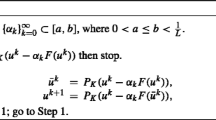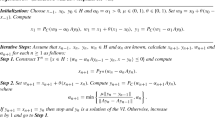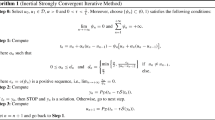Abstract
In this paper we introduce and study a general iterative scheme for the numerical solution of finite dimensional variational inequalities. This iterative scheme not only contains, as special cases the projection, linear approximation and relaxation methods but also induces new algorithms. Then, we show that under appropriate assumptions the proposed iterative scheme converges by establishing contraction estimates involving a sequence of norms in En induced by symmetric positive definite matrices Gm. Thus, in contrast to the above mentioned methods, this technique allows the possibility of adjusting the norm at each step of the algorithm. This flexibility will generally yield convergence under weaker assumptions.
Similar content being viewed by others
References
H.Z. Aashtiani and T.L. Magnanti, “Equilibria on a congested transportation network”,SIAM Journal on Algebraic and Discrete Methods 2 (1981) 213–226.
B.H. Ahn,Computation of market equilibria for policy analysis: the project independence evaluation system (PIES) approach (Gurland, New York, 1979).
R. Asmuth, B.C. Eaves and E.L. Peterson, “Computing economic equilibria on affine networks with Lemke's algorithm”,Mathematics of Operations Research 4 (1979) 209–214.
A. Auslender, “Problèmes de minimax via l'analyse convexe et les inégalités variationelles: theorie et algorithmes”, Lecture Notes in Economics and Mathematical Systems (Springer, New York, 1972).
D.P. Bertsekas and E.M. Gafni, “Projection methods for variational inequalities with application to the traffic assignment problem”, Tech. Rept., Laboratory for Information and Decision Systems, M.I.T., Cambridge, MA (1980).
H. Brezis and M. Sibony, “Méthodes d'approximation et d'iteration pour les opérateurs monotones”Archive for Rational Mechanics and Analysis 28 (1969) 59–82
R.E. Bruck, “An iterative solution of a variational inequality for certain monotone operators in Hilbert space”,Bulletin of the American Mathematical Society 81 (1975) 890–892.
S. Dafermos, “Traffic equilibrium and variational inequalities”,Transportation Science 14 (1980) 42–54.
S. Dafermos, “The general multimodal traffic equilibrium problem”,Networks, 12 (1982) 57–72.
S. Dafermos, “Relaxation algorithms for the general asymmetric traffic equilibrium problem”,Transportation Science 16 (1982) 231–240.
B.C. Eaves, “A locally quadratically convergent algorithm for computing stationary points”, Tech. Rep., Department of Operations Research, Stanford University, Stanford, CA (1978).
R. Glowinski, J.L. Lions and R. Trémolières,Analyse numérique des inéquations variationelles, méthodes mathématiques de l'informatique (Bordas, Paris, 1976).
N.H. Josephy, “Newton's method for generalized equations”, Tech. Rept. 1965, Mathematics Research Center, University of Wisconsin, Madison, WI (1979).
S. Karamardian, “Generalized complementarity problem”,Journal of Optimization Theory and Applications 8 (1971) 161–168.
D. Kinderlehrer and G. Stampacchia,An introduction to variational inequalities and applications (Academic Press, New York, 1980).
R. Kluge. Nichtlineare Variationsungleichungen und Extremaufgaben; Theorie und Näherungsverfahren (Deutscher Verlag der Wissenchaften, Berlin 1979).
J.J. Moré, “Coercivity Conditions in nonlinear complementarity problems”,SIAM Review 16 (1974) 1–15.
M.J. Smith, “Existence, uniqueness and stability of traffic equilibria”,Transportation Research 13B (1979) 295–304.
T. Takayama and G.G. Judge,Spatial and temporal price and allocation models (North-Holland, Amsterdam, 1971).
Author information
Authors and Affiliations
Rights and permissions
About this article
Cite this article
Dafermos, S. An iterative scheme for variational inequalities. Mathematical Programming 26, 40–47 (1983). https://doi.org/10.1007/BF02591891
Received:
Revised:
Issue Date:
DOI: https://doi.org/10.1007/BF02591891




